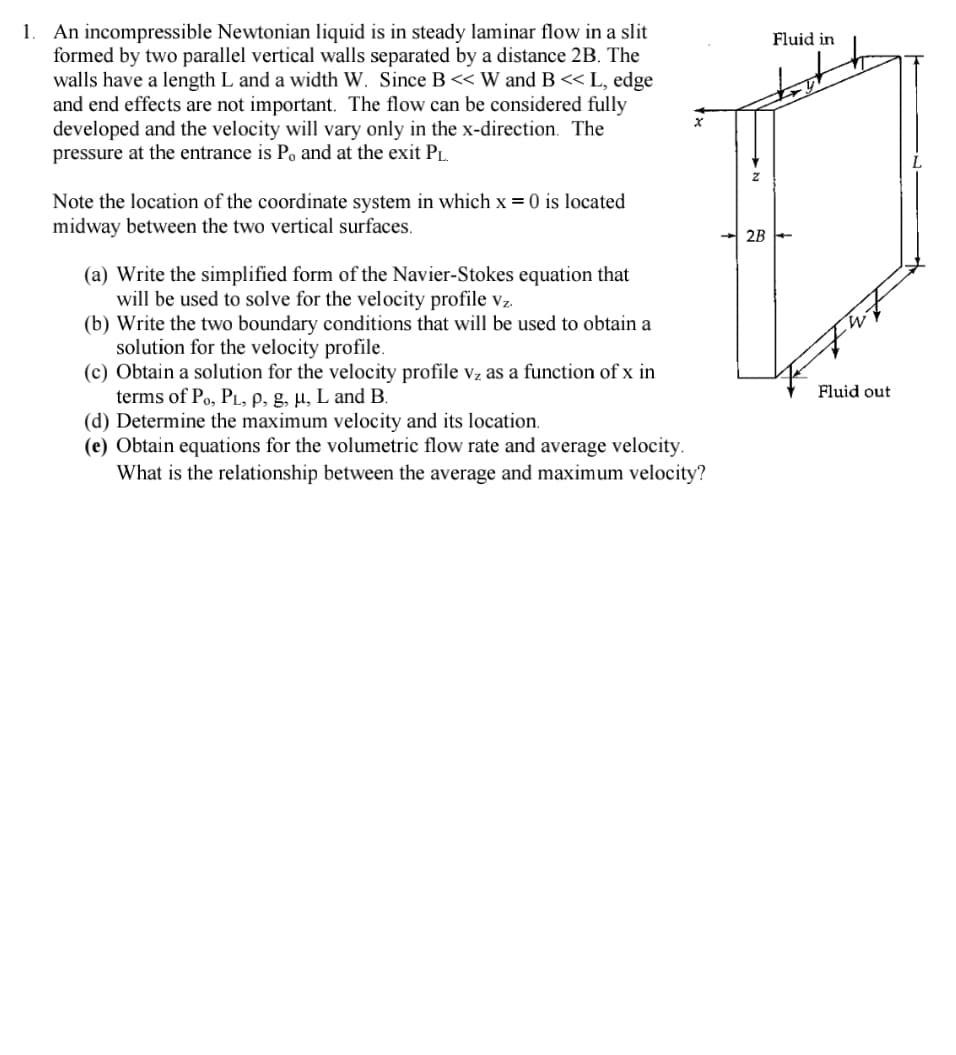1. An incompressible Newtonian liquid is in steady laminar flow in a slit formed by two parallel vertical walls separated by a distance 2B. The walls have a length L and a width W. Since B
1. An incompressible Newtonian liquid is in steady laminar flow in a slit formed by two parallel vertical walls separated by a distance 2B. The walls have a length L and a width W. Since B
Introduction to Chemical Engineering Thermodynamics
8th Edition
ISBN:9781259696527
Author:J.M. Smith Termodinamica en ingenieria quimica, Hendrick C Van Ness, Michael Abbott, Mark Swihart
Publisher:J.M. Smith Termodinamica en ingenieria quimica, Hendrick C Van Ness, Michael Abbott, Mark Swihart
Chapter1: Introduction
Section: Chapter Questions
Problem 1.1P
Related questions
Question
Answer a) and b)

Transcribed Image Text:1. An incompressible Newtonian liquid is in steady laminar flow in a slit
formed by two parallel vertical walls separated by a distance 2B. The
walls have a length L and a width W. Since B<W and B « L, edge
and end effects are not important. The flow can be considered fully
developed and the velocity will vary only in the x-direction. The
pressure at the entrance is Po and at the exit PL.
Fluid in
Note the location of the coordinate system in which x = 0 is located
midway between the two vertical surfaces.
2B -
(a) Write the simplified form of the Navier-Stokes equation that
will be used to solve for the velocity profile vz.
(b) Write the two boundary conditions that will be used to obtain a
solution for the velocity profile.
(c) Obtain a solution for the velocity profile vz as a function of x in
terms of Po, PL, P, g, µ, L and B.
(d) Determine the maximum velocity and its location.
(e) Obtain equations for the volumetric flow rate and average velocity.
What is the relationship between the average and maximum velocity?
ut
Fluid out
Expert Solution
This question has been solved!
Explore an expertly crafted, step-by-step solution for a thorough understanding of key concepts.
Step by step
Solved in 7 steps with 13 images

Knowledge Booster
Learn more about
Need a deep-dive on the concept behind this application? Look no further. Learn more about this topic, chemical-engineering and related others by exploring similar questions and additional content below.Recommended textbooks for you

Introduction to Chemical Engineering Thermodynami…
Chemical Engineering
ISBN:
9781259696527
Author:
J.M. Smith Termodinamica en ingenieria quimica, Hendrick C Van Ness, Michael Abbott, Mark Swihart
Publisher:
McGraw-Hill Education

Elementary Principles of Chemical Processes, Bind…
Chemical Engineering
ISBN:
9781118431221
Author:
Richard M. Felder, Ronald W. Rousseau, Lisa G. Bullard
Publisher:
WILEY

Elements of Chemical Reaction Engineering (5th Ed…
Chemical Engineering
ISBN:
9780133887518
Author:
H. Scott Fogler
Publisher:
Prentice Hall

Introduction to Chemical Engineering Thermodynami…
Chemical Engineering
ISBN:
9781259696527
Author:
J.M. Smith Termodinamica en ingenieria quimica, Hendrick C Van Ness, Michael Abbott, Mark Swihart
Publisher:
McGraw-Hill Education

Elementary Principles of Chemical Processes, Bind…
Chemical Engineering
ISBN:
9781118431221
Author:
Richard M. Felder, Ronald W. Rousseau, Lisa G. Bullard
Publisher:
WILEY

Elements of Chemical Reaction Engineering (5th Ed…
Chemical Engineering
ISBN:
9780133887518
Author:
H. Scott Fogler
Publisher:
Prentice Hall


Industrial Plastics: Theory and Applications
Chemical Engineering
ISBN:
9781285061238
Author:
Lokensgard, Erik
Publisher:
Delmar Cengage Learning

Unit Operations of Chemical Engineering
Chemical Engineering
ISBN:
9780072848236
Author:
Warren McCabe, Julian C. Smith, Peter Harriott
Publisher:
McGraw-Hill Companies, The